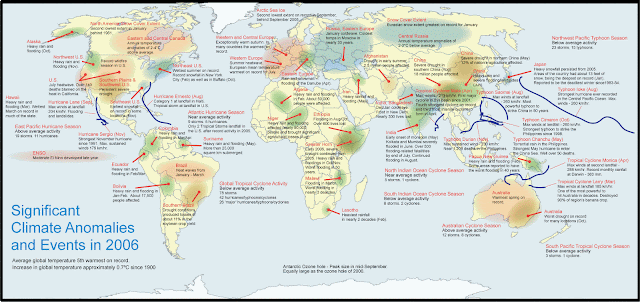2006 World Climate Data
- Global atmospheric CO2 concentration: 381.15 ppm, +2.17 ppm from 2005
- Surface air temperature anomaly: +0.64°C/1.15°F, 12th all-time 1880-2021
- Precipitation 34.0 (3%) mm above 1961-1990 global average
- Global mean sea level: 4.53 mm above 1993-2008 average, +1.43 mm from 2005
- Antarctic ozone hole: max. area 29.6 million km2; minimum O3 84 DU (Dobson Units)
- ENSO: Weak La Niña through April, neutral through August, El Niño through year’s end
Global Conditions
- Above-average temperatures: Scandinavia; China; Africa; southern South America
- Below-average temperatures: Central Russia
- Below-average precipitation: Australia
- Extreme precipitation: Amazon Basin; India; Philippines; Thailand; East Africa
Minimum and maximum extremes for sea ice extent occurred in the
Antarctic, while in the Arctic the second-lowest sea ice minimum in the
historical record occurred. The ozone hole in Antarctica reached is greatest
extent and lowest O3 values yet measured. Northern Hemisphere snow
cover was once again below average.
Globally, recent years have shown a trend—in both northern
and southern hemispheres—toward dryness early in the year (January-April) and
wetness later in the year (September-December). Longer-term, global
precipitation has increased 0.19% per decade since 1900, and 0.59% per decade
since the 70’s.
With the transition from La Niña to El Niño conditions,
during the middle (boreal summer/austral winter) of the year, the equatorial
Madden-Julian Oscillation (MJO) was active across the Pacific, bringing waves
of rain to northern South America. Outside of the Amazon Basin rainfall was
highly variable there, though later in the year the Caribbean was drier than
normal due to the onset of El Niño.
The global ocean continued to absorb CO2 at a
roughly consistent rate of 2.2 Pg/year (Pg = Petagrams = 1015 g =
one million billion grams), with an annual variability of ± 0.2 Pg, continuing
the acidification of the ocean. The Atlantic has generallyl tended to absorb more CO2
than the Pacific.
Tomorrow: 2007 State of the Climate, North America and
Europe.
Be brave, and be well.








No comments:
Post a Comment